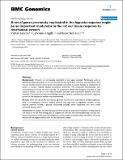| dc.contributor.author | Saxena, Vishal | |
| dc.contributor.author | Orgill, Dennis P. | |
| dc.contributor.author | Kohane, Isaac | |
| dc.date.accessioned | 2010-10-08T19:48:18Z | |
| dc.date.available | 2010-10-08T19:48:18Z | |
| dc.date.issued | 2007-11 | |
| dc.date.submitted | 2006-11 | |
| dc.identifier.issn | 1471-2164 | |
| dc.identifier.uri | http://hdl.handle.net/1721.1/58998 | |
| dc.description.abstract | Background: Wounds are increasingly important in our aging societies. Pathologies such as diabetes predispose patients to chronic wounds that can cause pain, infection, and amputation. The vacuum assisted closure device shows remarkable outcomes in wound healing. Its mechanism of action is unclear despite several hypotheses advanced. We previously hypothesized that micromechanical forces can heal wounds. To understand better the biological response of soft tissue to forces, rat ears in vivo were stretched and their gene expression patterns over time obtained. The absolute enrichment (AE) algorithm that obtains a combined up and down regulated picture of the expression analysis was implemented. Results: With the use of AE, the hypoxia gene set was the most important at a highly significant level. A co-expression network analysis showed that important co-regulated members of the hypoxia pathway include a glucose transporter (slc2a8), heme oxygenase, and nitric oxide synthase2 among others. Conclusion: It appears that the hypoxia pathway may be an important modulator of response of soft tissue to forces. This finding gives us insights not only into the underlying biology, but also into clinical interventions that could be designed to mimic within wounded tissue the effects of forces without all the negative effects that forces themselves create. | en_US |
| dc.publisher | BioMed Central Ltd | en_US |
| dc.relation.isversionof | http://dx.doi.org/10.1186/1471-2164-8-430 | en_US |
| dc.rights | Creative Commons Attribution | en_US |
| dc.rights.uri | http://creativecommons.org/licenses/by/2.0 | en_US |
| dc.source | BioMed Central Ltd | en_US |
| dc.title | A set of genes previously implicated in the hypoxia response might be an important modulator in the rat ear tissue response to mechanical stretch | en_US |
| dc.type | Article | en_US |
| dc.identifier.citation | BMC Genomics. 2007 Nov 23;8(1):430 | en_US |
| dc.contributor.department | Harvard University--MIT Division of Health Sciences and Technology | en_US |
| dc.contributor.mitauthor | Kohane, Isaac | |
| dc.relation.journal | BMC Genomics | en_US |
| dc.eprint.version | Final published version | en_US |
| dc.identifier.pmid | 18034909 | |
| dc.type.uri | http://purl.org/eprint/type/JournalArticle | en_US |
| eprint.status | http://purl.org/eprint/status/PeerReviewed | en_US |
| dc.date.updated | 2010-09-03T16:07:10Z | |
| dc.language.rfc3066 | en | |
| dc.rights.holder | Saxena et al.; licensee BioMed Central Ltd. | |
| dspace.orderedauthors | Saxena, Vishal; Orgill, Dennis; Kohane, Isaac | en |
| mit.license | PUBLISHER_CC | en_US |
| mit.metadata.status | Complete | |
